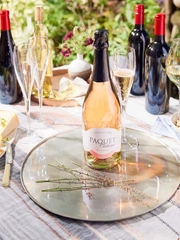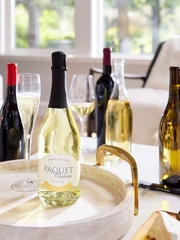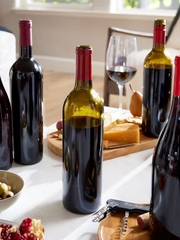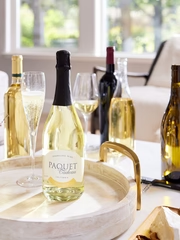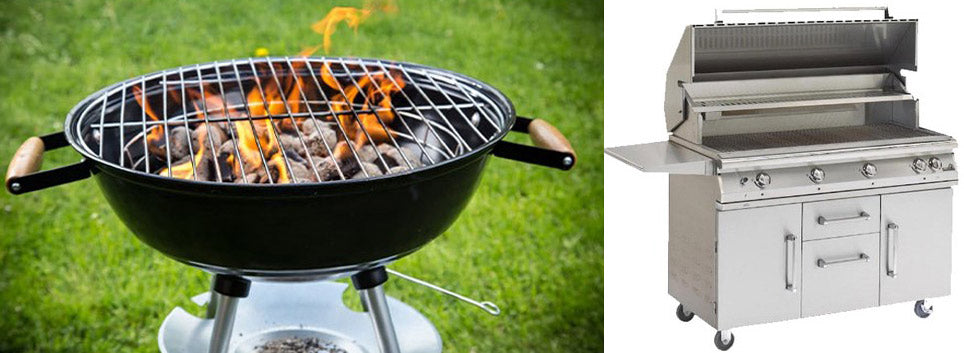 There are several types of grills used and each country has its preference. Most European countries use a gridiron over a bed of burning charcoal. In South America, both asado (beef roasted on a fire) and steak a la parrilla (beefsteak cooked on traditional grill) are national specialties. In the United States grilling is usually done on charcoal grills, gas grills or more recently with infrared barbecues. Skewers, rotisseries, kabob (to grill in Persian), "satay" in Asian cuisine, Mesquite, hickory wood chips and "alambre" in Mexican cuisine are becoming more and more present in American households.
There are several types of grills used and each country has its preference. Most European countries use a gridiron over a bed of burning charcoal. In South America, both asado (beef roasted on a fire) and steak a la parrilla (beefsteak cooked on traditional grill) are national specialties. In the United States grilling is usually done on charcoal grills, gas grills or more recently with infrared barbecues. Skewers, rotisseries, kabob (to grill in Persian), "satay" in Asian cuisine, Mesquite, hickory wood chips and "alambre" in Mexican cuisine are becoming more and more present in American households.
 Why do grilled food and wine pair together well?
In general, light-bodied wines come from white wine grapes and pair well with lighter dishes such as chicken, seafood, and grilled veggies. Bold, full-bodied red wines enhance the flavors in most types of meat, like burgers, steaks, and lamb, and also freshly grilled pizzas.
A well-seasoned steak tastes great with a peppery Zinfandel. Shrimp scampi goes really well with Chardonnay, but adding hot red pepper and garlic to the dish makes Zinfandel a possibly greater match because the spicy notes in the wine are complementing the pepper in the dish.
Why do grilled food and wine pair together well?
In general, light-bodied wines come from white wine grapes and pair well with lighter dishes such as chicken, seafood, and grilled veggies. Bold, full-bodied red wines enhance the flavors in most types of meat, like burgers, steaks, and lamb, and also freshly grilled pizzas.
A well-seasoned steak tastes great with a peppery Zinfandel. Shrimp scampi goes really well with Chardonnay, but adding hot red pepper and garlic to the dish makes Zinfandel a possibly greater match because the spicy notes in the wine are complementing the pepper in the dish.
 Sometimes opposites attract, like a crisp Chardonnay paired with flavor-packed Asian dishes. Dry wines, like Cabernet Sauvignons, work best with high-protein food, such as steak. They are rich in tannins, which help cleanse the palate of fats. For heavy meals with sauces, like lasagna or stews, think about a luscious Chardonnay or a full-flavored wine with high acidity (often found in Merlot or Cabernet Sauvignon) to cut through the oils in the dish.
Grilled food & wine pairings:
Shrimps, Lobster, Prawns, Catfish, Mahi Mahi, Bass, Salmon, Tilapia, Tuna or Pizza: le Cadeau Brut Sparkling Wine, Table White Wine, Dusk 2019 Rosé, Fact 2017 Chardonnay, Joy Cellars 2018 Chenin Blanc or Albion 2019 Chardonnay
Grilled Chicken, Turkey, Pork, Duck, Pheasant, Veal or Sausage: Family Ranch Heritage, Table Red Wine, Royal Mama Queenie’s Blend , Tatu Estates 2019 Shiraz
Lamb, Ribs, Beef Burgers, Ribeye or New York Strip Steaks: Terroir Cellars 2018 AOC L’Ouverture, Glory Cellars 2018 Cabernet Sauvignon , Sun Fish 2018 Petite Sirah, Deluge Storm, 2018 Artisan 5 Cabernet Sauvignon
Sometimes opposites attract, like a crisp Chardonnay paired with flavor-packed Asian dishes. Dry wines, like Cabernet Sauvignons, work best with high-protein food, such as steak. They are rich in tannins, which help cleanse the palate of fats. For heavy meals with sauces, like lasagna or stews, think about a luscious Chardonnay or a full-flavored wine with high acidity (often found in Merlot or Cabernet Sauvignon) to cut through the oils in the dish.
Grilled food & wine pairings:
Shrimps, Lobster, Prawns, Catfish, Mahi Mahi, Bass, Salmon, Tilapia, Tuna or Pizza: le Cadeau Brut Sparkling Wine, Table White Wine, Dusk 2019 Rosé, Fact 2017 Chardonnay, Joy Cellars 2018 Chenin Blanc or Albion 2019 Chardonnay
Grilled Chicken, Turkey, Pork, Duck, Pheasant, Veal or Sausage: Family Ranch Heritage, Table Red Wine, Royal Mama Queenie’s Blend , Tatu Estates 2019 Shiraz
Lamb, Ribs, Beef Burgers, Ribeye or New York Strip Steaks: Terroir Cellars 2018 AOC L’Ouverture, Glory Cellars 2018 Cabernet Sauvignon , Sun Fish 2018 Petite Sirah, Deluge Storm, 2018 Artisan 5 Cabernet Sauvignon
 However you choose to do it, chances are you will always find a wine to pair with all those flavorful culinary marvels.
Happy grilling and happy tasting!
However you choose to do it, chances are you will always find a wine to pair with all those flavorful culinary marvels.
Happy grilling and happy tasting!


